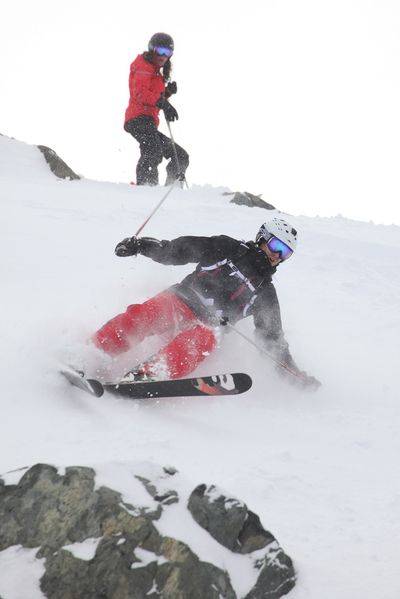Skiing class has steep learning curve

Cliff walls lined the chute below my skis. Clouds whirled overhead, snow bulleting in big flakes and filling in ski tracks almost as fast as we could make them. It was Day Two of a clinic at Whistler Blackcomb Resort in British Columbia, where for more than a decade a guide outfit called Extremely Canadian has run classes to teach the art of skiing the steep and the deep.
“It’s just snow, go for it!” My group’s instructor, Wendy Brookbank, was shouting from below. Her encouragement was meant to boost confidence on a run that dropped away as steep as most mountain climbs.
With caution I approached the edge. I leaned into a turn, my skis slicing, and I rocketed downhill with snow exploding all around.
For years I have been a steep-skiing freak. Chutes, high faces, double-diamond couloirs – these are the features I seek, and I am a confident skier. But a couple seasons off from serious skiing had made me rusty and introduced slop into my style. To remedy, I followed Brookbank and other coaches with Extremely Canadian last week in an attempt to tighten my technique and learn a few new tricks along the way.
The steep skiing clinic ($399) offers two days of serious instruction and fun. Like similar programs at resorts around North America, it’s made for intermediate to expert skiers willing to push beyond the groomed trail.
Our day at Whistler Blackcomb began with clouds and high winds. It was hard to see the snow in the flat light, and as such Brookbank’s first job was to teach us to ski when the visibility is bad. “I feel like I’m skiing by Braille,” said Scott Trepanier, a skier from Oregon.
Brookbank showed us to stay loose and absorb the ruts and bumps that in a whiteout we might miss. She demonstrated how to drag a ski pole on the uphill side during each turn to “stay in touch with the snow.” (It worked.)
When the clouds cleared, the instruction became more focused on the “extreme” steeps. We were taught tricks for balance (don’t over-rotate through a turn); for fighting fatigue (initiate all turns “with your ankles,” not your legs); and how to attack slopes with a purposeful pose (“point your thumb downhill” to lead the way, Brookbank explained).
A day in, I felt solid on almost anything Whistler Blackcomb could offer. We hit exposed faces, steeps on a glacier, and tight powder runs in the trees.
We shouldered our skis once and hiked uphill to gain access to a backcountry chute. Later, we leaped into a near-vertical bowl, my ski edges airborne for an instant before slicing into a run so steep I could reach out and touch snow.
Brookbank’s tips added up. Despite some nerves atop a chute that she warned was “really, really steep,” I sucked in and just “went for it,” as she had encouraged.
I pointed my thumb. I initiated a turn with my ankles, not my legs. I was skiing fast, edging smooth and beginning to get back into a steep-skiing groove I’d too long ago left behind.
On the Net: gearjunkie.com.